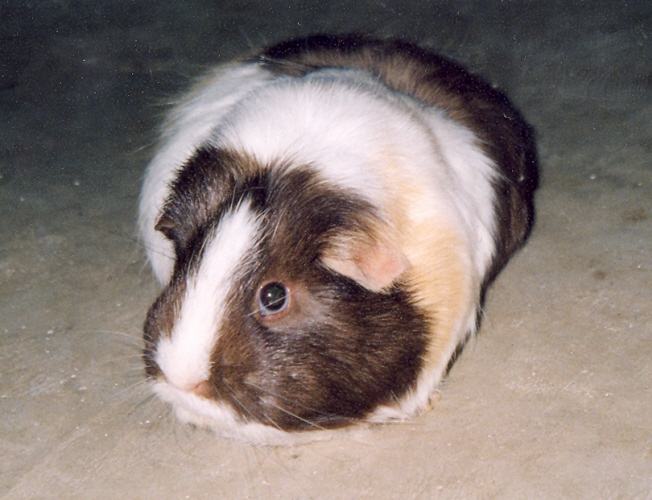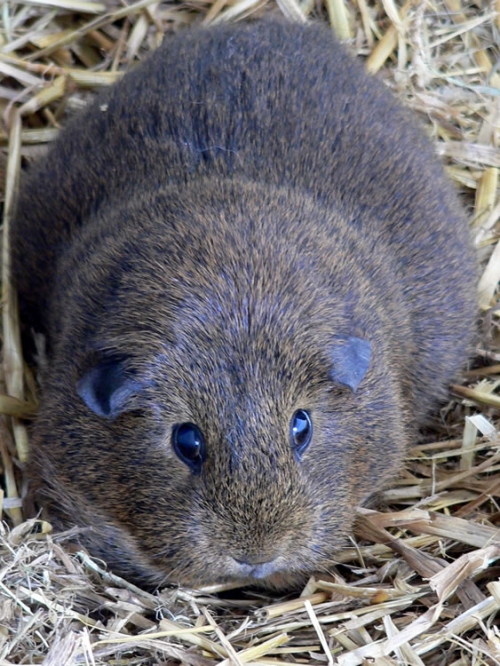

 :: Fantastic Facts of Friendly
Furballs
:: Fantastic Facts of Friendly
Furballs
 I chose to research
Cavia porcellus
because when I was younger I had a guinea pig of my
own, named Misty.
I adored her and her incessant squeaking for
romaine lettuce.
Along with that, I found guinea pigs interesting
for their diverse use around the world and through the
ages.
They’ve been used as food by the South American’s while
in
I chose to research
Cavia porcellus
because when I was younger I had a guinea pig of my
own, named Misty.
I adored her and her incessant squeaking for
romaine lettuce.
Along with that, I found guinea pigs interesting
for their diverse use around the world and through the
ages.
They’ve been used as food by the South American’s while
in
Long before the discovery of
Guinea pigs are famous for being used in scientific experiments. They have great biological similarities to humans in their hearing, immune system and need for certain vitamins. They have led to great breakthroughs including the discovery of Vitamin C, the tuberculosis bacterium, and adrenaline. With that, guinea pigs have contributed to 23 Nobel prizes for physiology or medicine. Follow this link to a great website on the scientific uses of guinea pigs.
 The name
‘guinea pig’ seems like an unusual name for this
creature, seeing as it’s not a pig, or even that it
didn’t originate from Guinea!
There are a couple theories on why the guinea
pigs name is what it is.
One is that the guinea pig has a similar physique
to that of a pig: a relatively large head compared to
their bodies, plump necks and rounded rumps with no tail
of any importance.
Also, some of the sounds they create are quite
similar to the lovely squeals made by pigs.
Another theory for the ‘pig’ part of the guinea
pigs name is that they are able to survive for long
periods of time in small spaces, like a ‘pig pen.’
The ‘guinea’ in guinea pig is a little more
difficult to explain.
Some are led to think that the creatures were
brought to Europe through Guinea, making people believe
the animal had originated from there.
Another theory says that back through the ages
‘guinea’ was frequently used as a reference to anything
that was from far-off, or from an unknown country, so
the name may have merely stuck to the animal through its
unbeknownst origin.
The name
‘guinea pig’ seems like an unusual name for this
creature, seeing as it’s not a pig, or even that it
didn’t originate from Guinea!
There are a couple theories on why the guinea
pigs name is what it is.
One is that the guinea pig has a similar physique
to that of a pig: a relatively large head compared to
their bodies, plump necks and rounded rumps with no tail
of any importance.
Also, some of the sounds they create are quite
similar to the lovely squeals made by pigs.
Another theory for the ‘pig’ part of the guinea
pigs name is that they are able to survive for long
periods of time in small spaces, like a ‘pig pen.’
The ‘guinea’ in guinea pig is a little more
difficult to explain.
Some are led to think that the creatures were
brought to Europe through Guinea, making people believe
the animal had originated from there.
Another theory says that back through the ages
‘guinea’ was frequently used as a reference to anything
that was from far-off, or from an unknown country, so
the name may have merely stuck to the animal through its
unbeknownst origin.
The guinea pig has some interesting relatives. It is related to the porcupine, the chinchilla, the mara and the capybara. The capybara is the largest rodent and can weigh up to 100 pounds!
The guinea pig: an animal that has aided in scientific discoveries, a great pet, and a delightful meal. What is not to find interesting about this wonderful creature?



 :: LINKS
:: LINKS



 :: Learn More About:
:: Learn More About:

